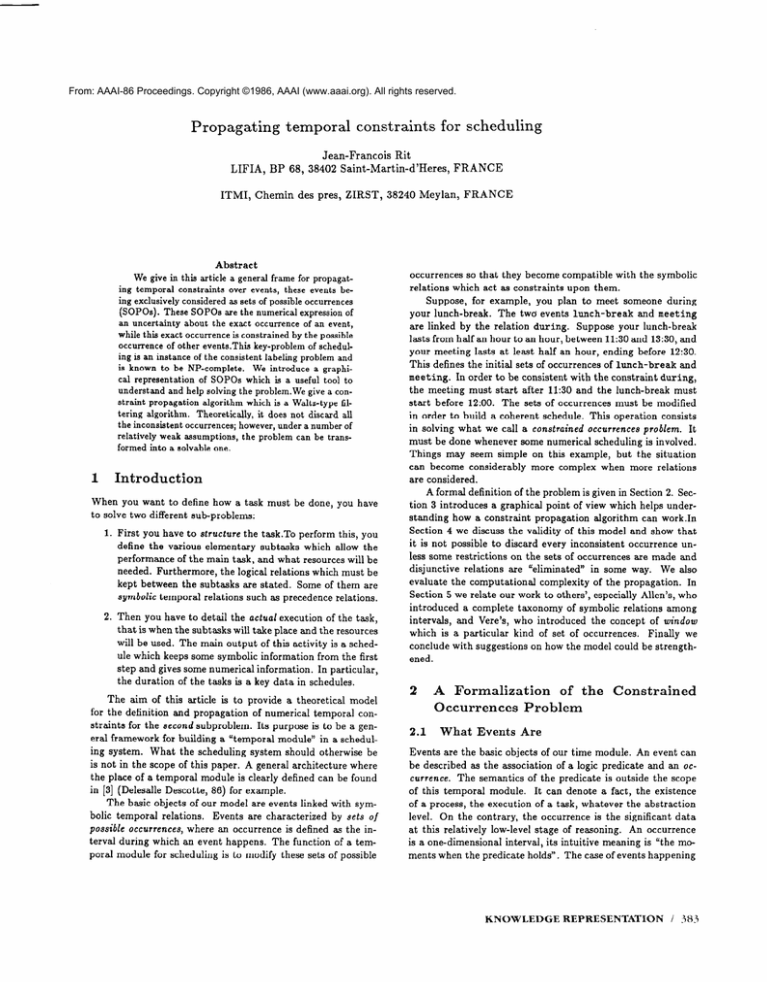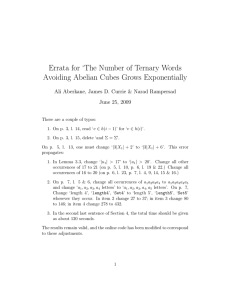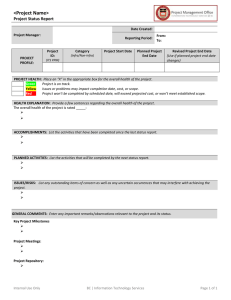
From: AAAI-86 Proceedings. Copyright ©1986, AAAI (www.aaai.org). All rights reserved.
Propagating
temporal
constraints
Jean-Francois
for scheduling
Rit
LIFIA, BP 68, 38402 Saint-Martin-d’Heres,
FRANCE
ITMI, Chemin des pres, ZTRST, 38240 Meylan, FRANCE
Abstract
We give in this article a general frame for propagating temporal constraints over events, these events being exclusively considered as sets of possible occurrences
(SOPOs). These SOPOs are the numerical expression of
an uncertainty about the exact occurrence of an event,
while this exact occurrence is constrained by the possible
occurrence of other events.Thiz key-problem of scheduling is an instance of the consistent labeling problem and
is known to be NP-complete. We introduce a graphical representation of SOPOs which is a useful tool to
understand and help solving the problem.We give a constraint propagation algorithm which is a Waltz-type filtering algorithm. Theoretically, it does not discard all
the inconsistent occurrences; however, under a number of
relatively weak assumptions, the problem can be transformed into a solvable one.
occurrences so that they become compatible with the symbolic
relations which act as constraints upon them.
Suppose, for example, you plan to meet someone during
your lunch-break. The two events lunch-break
and meeting
are linked by the relation during.
Suppose your lunch-break
lasts from half an hour to an hour, between 11:30 and 13:30, and
your meeting lasts at least half an hour, ending before 12:30.
This defines the initial sets of occurrences of lunch-break
and
meeting.
In order to be consistent with the constraint during,
the meeting must start after l1:30 and the lunch-break must
start before 12:O0. The sets of occurrences must be modified
When you want to define how a task must be done, you have
in order to build a coherent schedule. This operation consists
in solving what we call a constrained occurrences problem. It
must be done whenever some numerical scheduling is involved.
Things may seem simple on this example, but the situation
can become considerably more complex when more relations
are considered.
A formal definition of the problem is given in Section 2. Section 3 introduces a graphical point of view which helps under-
to solve two different sub-problems:
standing
1
Introduction
1. First you have to structure the task.To perform this, you
define the various elementary subtasks which allow the
performance of the main task, and what resources will be
needed. Furthermore, the logical relations which must be
kept between the subtasks are stated. Some of them are
symbolic temporal relations such as precedence relations.
2. Then you have to detail the actual execution of the task,
that is when the subtasks will take place and the resources
will be used. The main output of this activity is a schedule which keeps some symbolic information from the first
step and gives some numerical information. In particular,
the duration of the tasks is a key data in schedules.
.
The aim of this article is to provide a theoretical model
for the definition and propagation of numerical temporal constraints for the second subproblem.
Its purpose is to be a gen-
era1 framework for building a “temporal module” in a scheduling system. What the scheduling system should otherwise be
is not in the scope of this paper. A general architecture
where
the place of a temporal module is clearly defined can be found
in [3] (Delesalle Descotte, 86) for example.
The basic objects of our model are events linked with symbolic temporal relations. Events are characterized by sets of
possible occurrences, where an occurrence is defined as the interval during which an event happens. The function of a temporal module for sched uling is to modify these sets of possible
how a constraint
propagation
algorithm can work.In
Section 4 we discuss the validity of this model and show
it is not possible to discard every inconsistent occurrence
less some restrictions on the sets of occurrences are made
disjunctive relations are “eliminated” in some way. We
evaluate the computational complexity of the propagation.
Section 5 we relate our work to others’, especially Allen’s,
introduced
a complete
taxonomy
of symbolic
that
unand
also
In
who
relations among
intervals, and Vere’s, who introduced the concept of window
which is a particular kind of set of occurrences.
Finally we
conclude with suggestions on how the model could be strengthened.
2
2.1
A Formalization
of the Constrained
Occurrences Problem
What
Events Are
Events are the basic objects of our time module.
An event can
be described as the association of a logic predicate and an occurrence. The semantics of the predicate is outside the scope
of this temporal
module.
It can denote a fact, the existence
of a process, the execution of a task, whatever the abstraction
level. On the contrary, the occurrence is the significant data
at this relatively low-level stage of reasoning. An occurrence
is a one-dimensional interval, its intuitive meaning is “the moments when the predicate holds”. The case of events happening
KNOWLEDGE REPRESENTATION / 383
over multiple intervals, like having-lunch
(which happens ev-
ery day), is not considered here. At a higher level, such events
can be easily decomposed into elementary subevents happening
over single intervals.
Handling events with a uniquely defined occurrence is not
very interesting. In most cases, the occurrence of an event is
numerically constrained : it belongs to a domain where the
duration, beginning and end of the occurrence
are constrained.
This domain is called the set of possible occurrences (SOPO).
It should be now obvious that the meaning of the predicate is
not relevant to the temporal module point of view.
2.2
Linking Events
with Temporal
I
I
0
1
J
3
Figure 1: one-dimensional
problem is :
Discarding from Or,, . . , 0,
I
t
I
5
+
6
8
representation
of occurrences
the occurrences
which do not be-
long to any solution.
Of course, finding all the solutions of R would be more satisfying, but it is impossible to explicitly represent them since the
SOPOs contain an infinite number of elements. It is then necessary to keep implicitly the solutions in the SOPO-based representation. In order to “extract” a solution, you must choose
Relations
The second type of input data are relational data. They are
temporal links between events and are mainly derived from
higher level descriptions of the world. For example, suppose
you want to buy something, then your action of paying happens during buying because paying is hierarchically a subtask
of buying.
Moreover paying happens before
getting
the
object because paying is a condition of getting
For the temporal module, all the relations
I
the object.
are translated
one occurrence o in a SOPO. If the constrained occurrences
problem has been solved, o belongs to at least one solution.
Choosing o is equiva!ent to defining a new SOPO, thus a new
constrained occurrences problem.
Solving this new problem
will give all the solutions containing o.
Naturally, you can more generally choose a subset of a
SOPO. As long as R is not changed, you know that the new
constrained occurrences problem has some solutions.
into a low-level set of primitives which describe the relationship
between two intervals. These primitives are before,
during,
overlap...
A complete enumeration was given by Allen [l].
However, these primitives are used to link two intervals, and
we want to link SOPOs. This requires some formalization.
A
temporal relation is a boolean function defined over the SOPOs
of two events (we will also say that it is defined between these
events). The arguments of such a relation are therefore two
intervals :
R12 : 01x02
+
{W
(w32)
H
R12(01,02)
Where R12 is a temporal
relation, Or and 02 are SOPOs,
or,02 are occurrencesThis
the parameters of orandoz
and
b(o) the beginning of o
is a solution of a set of
: beginning
and end. This is
a solution of a set of temporal
where all the temporal
relations is a deand
Occurrences
following manner : the beginning and the end of any occurrence
o are dates and can then be “projected,, onto the diagonal (fig
representation
of o. It is thus possible to switch easily from one
point of view to the other : 2-D for sets of occurrences,
1-D for
occurrences.
relations are satisfied.
The Constrained
occurrences whose beginning equals the end, thus the locus of
dates. This links the 2-D representation with the 1-D one in the
2). The segment defined by these two dates is the set of all the
“instants,, forming o, in other words, this segment is the 1-D
Rjk(oj,ok) = 1
of a world where each event has one occurrence
Problem
Let er, . . . ,e, be events, Or,. . . , 0, their SOPOs and R a set
of relations between the events. The constrained occurrences
/ SCIENCE
with two parameters
they end, all possible ones belong to the dotted region of fig 2.
The main diagonal has a particular meaning: it is the locus of
V.j,k E [Ml,
384
beginning cannot belong to [4,5]. This ambiguity comes from
the 2-dimensional nature of an occurrence : it is completely
be n SOPOs and or,. . . , o, be n occurrences
The set {oi,i E [l,n]} 0 f occurrences
relations { Rjk, j, k E [1, n]} iff :
2.3
ning after 2 and ending before 6, or the set of such occurrences
with a duration equal to 3, or the set of occurrences whose
b(o2) > e(a)
= 1 *
Vi E [l,n],OiE Oi
scription
of occurrences
An occurrence being a numerical interval, a one-dimensional
line is an obvious graphical aid for representing occurrences
determined
such that
Semantically,
A 2-D representation
of Con-
why we use, as a graphical aid, the plan of occurrences with
beginning and end axis (fig 2). As occurrences begin before
R(ol,oz)
Let Or,. . . , 0,
3.1
A Graphical Representation
strained SOPOs
and relations between them (fig 1). However, a 1-D representation is ambiguous because SOPOs have to be represented with
intervals whereas they are sets of intervals. For example, the
interval on fig 1 could represent the set of occurrences begin-
relation express a constraint over
(beginning, end and duration). For
example, if Rl2 is the relation before,
and e(o) the end of o:
3
Fig 3 is a unambiguous
fig 1 cannot represent.
representation
of the SOPOs
that
end
begin
Figure 2: two-dimensional
representation
begin
Figure 4: A mapping of the plan using Allen’s primitives
of occurrences
end
Figure 5: An example of a disjunctive
constraint
Figure 3: Fig 1 revisited with a 2-D representation
is a segment (fig 7). The SOP0
3.2
2-D Representation
of Relations
and SOPOs
Let R be a temporal relation, and o an occurrence, the set of all
the occurrences verifying the relation R with o, {z/R(z,
o) =
l}, is a generally easily representable region in the plan.
will call it the region allowed by o and R.
We
Fig 4 is a “complete” mapping of the plan with the set of
temporal relations given by Allen [I]. Any occurrence on it can
be temporally
related to o. Of course, there are obviously other
of a given event can theoreti-
cally have any shape. However, in the following, we will speak
only of one sort of SOPO, unless otherwise stated, namely the
generalized window where the beginning, end and duration of
an occurrence are independantly bounded. This simple representation covers a fair number of cases. The shape of such a
end
ways of mapping, with more or less primitives, depending on
how complex the temporal module should be. We will keep this
one in the following.
Disjunctive
relations can be represented as the union of the
regions allowed by the parts of the disjunction (fig 5). In the
same way, conjunctions are represented through the graphical
intersection of regions (fig 6).
A SOP0 is also a region of the plan.
The simplest SOP0
(except the trivial occurrence set) is the window, using Vere’s
(one-dimensionnal)
(71 t erminology. Occurrences in a window
begin
must begin after an earliest start time and end before a latest
finish time. If their duration is not constrained, the window
has a triangular shape, if their duration is given, the window
Figure 6: An example of a conjunctive
KNOWLEDGE
relation
REPRESENTATION
/ 385
end
begin
begin
earliest start time
Figure 9: Propagation
of a constraint
on a SOP0
Figure 7: windows
This is the basis of a temporal constraint propagation. Each
time a SOP0 Oi is constricted, the regions allowed by 0; and
any relation &j involving Oi are constricted. If the SOPOs Oj
end
such that Oi &j Oj are therefore constricted, the propagation
must be furthered. The general structure of the algorithm is
thus :
latest
finish
time
begin
while S # 0
for i = 1,n
if Oi E S
for j = 1, n
earliest
finish
time
ifOjflA(Oi,&j)
l/J
lajst
start time
begg
endfor
s + s - (Oi)
endif
endfor
endwhile
start time
Figure 8: a generalized window
SOP0
is on fig 8.
3.3
Propagation
SOPOS
Returning
end
of Temporal
to the problem
of temporal
Constraints
relations,
a SOP0
over
can
be considered as a disjunctive clause where each part of the
clause is a single occurrence. In this respect, given a relation R
and a SOP0 Or, we can define a region allowed by 01 and R as
the union of the regions allowed by each occurrence
in Or and
R (formally, this allowed region is {z / 30 E Or /R(z,
o) = 1)).
If R is defined between Or and a SOP0
any occurrence
and
An interesting feature of this method is that disjunctive constraints can be propagated. Disjunctive constraints can create
“holes” in a SOPO. In fig 10, the SOP0 Or creates a hole in
the window 02 which therefore loses its connexity. However,
constraints
involving
kind of common
02 can still be propagated,
information
furthering
a
about the two parts of 02.
4
Evaluating
the Algorithm
may
do so. On a dual point of view, the intersection of all such
regions({z /Vo E Or, R(z, o) = 1)) defines a “certain” region :
all the elements of 02 in this region belong to a solution, whatever the choice of an element in Or, whereas the elements which
do not belong to this certain region might not belong to any
solution (fig 9).
/ SCIENCE
where S is the set of modified SOPOs to be checked
A (Oi , &j) is the region allowed by Oi and R+j.
02, this means that
of 02 that does not belong to this region does
not belong to any solution, whereas the other occurrences
3%
#0
Oj + OjnA(Oi,&j)
S + SU{Oj}
endif
4.1
Consistency
The constrained occurrences problem belongs to a class of problems which received much attention in Artificial Intelligence
and Operational Research, namely the consistent labeling problem. In our case, the domain of variables is not finite because
it is continuous.
end
end
not discarded by
propagating
“before (01,02) or
after (0 1,02)”
Cl
discarded, thus
creating a hole
I
begin.
Figure 11: A bad case for constraint
Figure 10: Making a hole in a SOP0
propagation
case of contradictory
relations. For example, on fig 11,
e = 4 for A and B : you must apply four times the
The algorithm we gave for temporal constraint propagation
in section 3.3 is the same than Waltz’s algorithm [8] used for
scene analysis problems. According to Mackworth’s terminology (41 it achieves only arc-consistency because it only checks
constraints before
(A,B)
to remove this inconsistent
and before
conjunction.
(B.A)
in order
consistency between pairs of SOPOs. As defined in section 2.2,
belonging to a solution is a global property of an occurrence.
r is the average number of relations involving a given event. If
r is big, the algorithm will be more costly, having more
A local check between pairs of SOPOs is necessary but not
sufficient.
This is why such an algorithm is only a filtering
algorithm, it ‘lets go by” inconsistent occurrences.
constraints to propagate. But the “information” of a constriction will be propagated more efficiently, thus lowering
In fact the consistent labeling problem is NP-complete [4].
However, if the SOPOs are generalized windows, and if the
disjunctive
relations me eliminated
by enumerating
the differ-
ent terms, the constrained occurrences problem can be solved
with an arc-consistency algorithm (see [S] for hypotheses a bit
weaker than generalized windows). Such an elimination should
come after the arc-consistency
elimination, otherwise the interest in our formalism
of propagating
disjunctions
would be
greatly spoiled.
4.2
e.
c depends on the “shape” of the SOPOs, and not on their number. If the shape is very complicated (for example with a
lot of holes) the global efficiency will be lowered. In fact, c
is directly bound to the number of disjunctions, since they
make holes into SOPOs, thus complicating their shape.
As an example,
if r is biggest, e lowest, the complexity of the
algorithm is cn2. It is analogous to the complexity of arcconsistency algorithms : Nn2, where N would be the number
of elements in a SOPO. But we must repeat here that the true
complexity can be highly variable.
Complexity
We will consider here only the complexity of the arc-consistency
algorithm since it is the heart of the constraint propagation
algorithm.
We saw in section 3.3 that each time a SOP0 is
5
modified,
Many systems were designed to be temporal modules. They
all suppose that occurrences are intervals (or their degenerated
But they differ in the objects they describe
form : points).
a consistency
of the algorithm
check must be made.
The complexity
is then :
number of constrictions
x cost of a consistency
check
( number of constricted SOPOs x number of constrictions
$r SOPO) X ( number of relations per SOP0 x cost of a
consistency
check between two SOPOs)
Related
best and thus belong to two families : numerical and symbolic
systems.
Symbolic
temporal
NnXeXrXc
The evaluation
of this expression is in fact quite difficult :
n number of events or SOPOs,
is precisely defined and cannot
be influenced.
e measures the efficiency of the constrictions, e = 1 means that
each SOP0 is modified once with a “one-shot”, definitive
constriction. Unfortunately, things can go very bad in the
Works
systems put the emphasis on the description
relations.
of
In [l] (Allen 83) a relation is a disjunction
of primitives which are very cleanly built in [2] (Allen Hayes 85)
from the “meet” relation between two intervals. This representation allows a very easy computation of conjunctive relations
(AqB A Ar2B ---+ ArsB) which is in some way an intersection of combinations.
Moreover, Allen gives a table for computing the composition of relations (AqB A Br2C --+ ArsC).
This allows the computation of path-consistency
(according to
Mackworth’s
terminology
[4]) which is more complete
than an
KNOWLEDGE REPRESENTATION i 387
arc-consistency,
hence a O(n3)
complexity,
where n is the num-
ber of events. However, the system only deals with symbols, so
numerical data are not efficiently handled, especially duration.
On the other hand, numerical systems put the emphasis on
the description of occurrences. The beginning and the end of an
occurrence are explicitly represented with two numbers. DEVISER [7] (V ere 83) is a planning system where the windows
were first introduced.
They are compressed in the same way
that we constrict our SOPOs.
The hypotheses of DEVISER
ensure that the arc-consistency
is sufficient to solve the con-
strained occurrences problem. However, all Allen’s primitives
are not representable (some are with an astute use of the for-
concepts.
All the solutions
give visual “patterns”
good solutions.
useful for detecting the presence of
Acknowledgements
This paper benefited greatly from discussions with Y. Descotte
and from the useful comments of J-C Latombe and J. Crowley.
References
agated.
[3] H. Delesalle Y .D escotte
[l] J. F. Allen, Maintaining
ternational
We gave in this article a general frame for propagating temporal
by the possible occurrence of other events. Making the SOPOs
compatible with the temporal constraints is what we call a constrained occurrence.9 problem. This key-problem for scheduling,
is an instance of the consistent labeling problem and is known
to be NP-complete.
We introduce a graphical representation of
SOPOs which enables the visualization of a constraint prop
agation algorithm.
This algorithm is a Waltz-type filtering
algorithm
[8], it d oes not remove every inconsistency,
the SOPOs are of the “generalized
disjunctions are removed.
We are developping
unless
window” type and all the
our current reflections along two axis :
1. Making the algorithm more efficient. The complexity
can
be variable, depending on how effectively the constraints
are propagated. In an ideal network of constraints, every
SOP0 is linked to the other so that only one constriction is sufficient (i.e. the whole information is propagated
during the first shot along the links). If there is a number of constrictions over one SOPO, this means that the
temporal
relations involving
comparison
with the implicit
the SOP0
constraint
are too weak in
of the net.
For
a greater efficiency, the topology of the net should be
changed, making explicit the actual constraints. Such a
symbolic inference can be done using Allen’s [l] symbolic
propagation,
2. Using the temporal
388
/ SCIENCE
module
for higher level scheduling
November
83, Volume 26,
[2] J. F. Allen and P. J. Hayes A common sense theory of time,
in proc. IJCAI 85, Los Angeles, USA, August 85, pp 528
531.
Workshop
cations, Avignon,
constraints over events, these events being exclusively considered as sets of possible occurrences (SOPOs). These SOPOs are
the numerical expression of an uncertainty about the exact occurrence of an event, while this exact occurrence is constrained
knowledge about temporal intervals
Communications
of the ACM,
Number 11, pp 832-843.
pour la planification
Conclusion
occurrence
should require minor adjustments when a perturbation
occurs. In this respect, a graphical point of view might
malism) and disjunctions cannot be propagated. Moreover, the
temporal relations are inside the system since they are implicitly deduced from the plan structure, so the user has no access
to them. Smith [6] proposes a temporal module for the ISIS
job-shop scheduling system. ISIS builds a hierarchical task net
with resources and Smith’s temporal module propagates the
reservations of these resources through the net, also using window compressing. Here the plan structure is also the only way
of specifying temporal relations, and disjunctions are not prop-
6
of a constrained
problem are not good ones. Qualifying solutions involves
high level concepts such as robustness. A robust schedule
Une architecture de systeme expert
d’activite (in french), in proc. 6th Inon Expert Systems and their Appli-
France, April 86, pp 903-916.
[4] A. K. Mackworth Consistency in network8 of relations, Artificial Intelligence 8 (1977), pp 99118.
[S] J-F Rit Vera une representation
du temps pour la planification (in french) memoire de DEA, Institut National Polytechnique de Grenoble, June 85.
[6] S. Smith
Exploiting
temporal
knowledge
straints Technical report CMU-RI-TR-83-12,
to organize
con-
Carnegie Mel-
lon University, July 83.
[7] S.Vere Planning
in time : Windows and durations for actiwitiee and goals, IEEE trans. on PAMI, Vol. PAMI-5:3,
May 1983, pp 246267
[8] D. L. Waltz.
ing of scenes
G enerating semantic descriptions from drawwith shadows MAC AI-TR-271 MIT 1972






